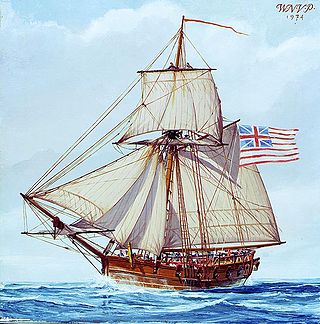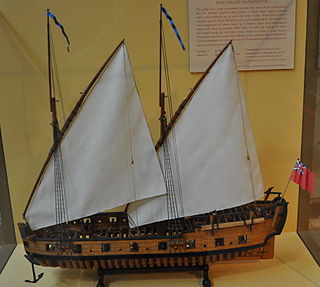
The Battle of Valcour Island, also known as the Battle of Valcour Bay, was a naval engagement that took place on October 11, 1776, on Lake Champlain. The main action took place in Valcour Bay, a narrow strait between the New York mainland and Valcour Island. The battle is generally regarded as one of the first naval battles of the American Revolutionary War, and one of the first fought by the United States Navy. Most of the ships in the American fleet under the command of Benedict Arnold were captured or destroyed by a British force under the overall direction of General Guy Carleton. However, the American defense of Lake Champlain stalled British plans to reach the upper Hudson River valley.
USS Enterprise was a Continental Army sloop-of-war that served in Lake Champlain during the American Revolutionary War. She was the first of a long and prestigious line of ships of the United States or by the combatant forces of the U.S. Revolutionary War to bear the name Enterprise.

The capture of Fort Ticonderoga occurred during the American Revolutionary War on May 10, 1775, when a small force of Green Mountain Boys led by Ethan Allen and Colonel Benedict Arnold surprised and captured the fort's small British garrison. The cannons and other armaments at Fort Ticonderoga were later transported to Boston by Colonel Henry Knox in the noble train of artillery and used to fortify Dorchester Heights and break the standoff at the siege of Boston.

USS Providence was a sloop-of-war in the Continental Navy, originally chartered by the Rhode Island General Assembly as Katy. The ship took part in a number of campaigns during the first half of the American Revolutionary War before being destroyed by her own crew in 1779 to prevent her falling into the hands of the British after the failed Penobscot Expedition.
USS Julia was a schooner in the United States Navy during the War of 1812. Initially the privately-owned schooner Julia, she was captured at the onset of the war by armed boats looking for violators of President James Madison's embargo of trade with the British. Purchased by the United States Navy, the vessel was armed with two guns and made part of the squadron on Lake Ontario. Julia took part in the Battle of York and the Battle of Fort George. In August 1813, the schooner was captured by the Royal Navy after failing to execute a turn and was put in service as HMS Confiance. The vessel continued as a warship in British service for a couple of weeks before being converted to a troop transport. In October, Confiance was recaptured by the Americans and renamed Julia. No longer considered capable as a warship, the vessel was retired from service.

The first USS Revenge was a Schooner in the Continental Navy. Revenge was built in the summer of 1776 by Colonel Jeduthan Baldwin at Fort Ticonderoga, New York.

USS Philadelphia is a gunboat of the Continental Navy. She was constructed from July–August 1776 for service during the American Revolutionary War. Manned by Continental Army soldiers, she was part of a fleet under the command of General Benedict Arnold that fought against the British Royal Navy in the Battle of Valcour Island on Lake Champlain. Philadelphia was sunk during the battle on 11 October 1776.

HMS Little Belt was the mercantile sloop Friends Good Will, launched in 1811, which the British captured shortly after the start of the War of 1812. The British took her into service as Little Belt, armed her with three guns, and incorporated her into the Royal Navy's Lake Erie fleet. The American schooner Scorpion captured her during the Battle of Lake Erie and the Americans took her into service under her existing name. A storm drove her ashore in October 1813 and a British expeditionary force burnt her in December 1813.
HMS Chippawa, or Chippeway, was the mercantile schooner Chippawa, built and launched in 1810. The British brought her into service as HM Schooner Chippawa, sometimes recorded as Chippeway.

USS Washington was a lateen-rigged, two-masted galley in the service of the Continental Congress during the American Revolutionary War. Washington was capable of propulsion by sail or by the rowing of oarsmen. During a battle with British warships, Washington "struck her colors" and was captured by the British.

USS Viper – commissioned as USS Ferret – was a brig serving the United States Navy during the early days of the republic. Viper was assigned to enforce the Embargo Act of 1807 along the U.S. East Coast. During the War of 1812, while cruising in the Caribbean, she was captured by the more heavily armed British warships. She then served the Royal Navy as HMS Mohawk until the Navy sold her in 1814. While in British service she served in several actions that earned her crew the Naval General Service Medal,
USS Providence, a gundalow, was built at Skenesboro, New York, on Lake Champlain by the Continental Army for Brigadier-General Benedict Arnold's fleet on Lake Champlain in 1776, during the American Revolutionary War.
USS Lee was a galley built for the Continental Navy during the American Revolution. She participated in the Battle of Valcour Island during which she was grounded and lost. However, her participation in the battle helped delay the British advance on New York City by a year.
USS Spitfire was an American gundalow that operated as a gunboat in 1776 on Lake Champlain. She was part of Benedict Arnold's small, hastily built fleet of ships whose purpose was to counter any British invasion forces passing through the lake from Canada. Her service life was brief; after only a few months patrolling the lake she was lost in the aftermath of the Battle of Valcour Island. The gunboat's wreck was located and documented in the 1990s by the Lake Champlain Maritime Museum.

American colonial marines were various naval infantry units which served during the Revolutionary War on the Patriot side. After the conflict broke out in 1775, nine of the rebelling Thirteen Colonies established state navies to carry out naval operations. Accordingly, several marine units were raised to serve as an infantry component aboard the ships of these navies. The marines, along with the navies they served in, were intended initially as a stopgap measure to provide the Patriots with naval capabilities before the Continental Navy reached a significant level of strength. After its establishment, state navies, and the marines serving in them, participated in several operations alongside the Continental Navy and its marines.
New York (1776) was a gunboat built in 1776 at Skenesboro, New York. It was originally called Success prior to launch for service in General Benedict Arnold's fleet on Lake Champlain. New York may be named after the City of New York, because other ships in the fleet were named after cities, however, it could be named after the State of New York, because at least one or two other ships, Connecticut and Jersey, sometimes referred to as New Jersey, were named after states.

Royal Savage was a two-masted schooner built by the British in the summer of 1775. She was damaged and sunk by soldiers of the United Colonies during the Siege of Fort St. Jean and later raised and repaired after the fort was captured. She then participated in General Benedict Arnold's campaign on Lake Champlain. The British captured and burnt her in October 1776 at Valcour Island.
The first USS Trumbull was a row galley built in 1776 at Skenesboro, New York, for service in General Benedict Arnold's fleet on Lake Champlain. She was launched on 10 September 1776 and began active service soon thereafter, Capt. Seth Warner in command.

The first USS Mosquito was believed to have been purchased at Philadelphia late in 1775 for the new Continental Navy. She patrolled the Delaware River until destroyed during the British capture of Philadelphia led by the Howe brothers and completed by them in October 1777. The Dictionary of American Naval Fighting Ships (DANFS) has identified this ship as a sloop, yet records from the period which are believed to refer to the ship have consistently identified her as being a schooner. These records also provide a bit more detail of her fate, indicating she was burned after capture in July 1777 during Royal Navy operations along the Delaware River.









